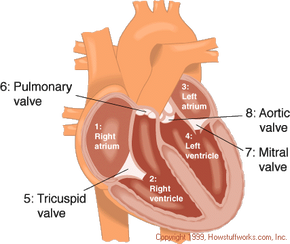Chambers and Valves
The heart is divided into four chambers: (see Figure 2)
- right atrium (RA)
- right ventricle (RV)
- left atrium (LA)
- left ventricle (LV)
Each chamber has a sort of one-way valve at its exit that prevents blood from flowing backwards. When each chamber contracts, the valve at its exit opens. When it is finished contracting, the valve closes so that blood does not flow backwards.
Advertisement
- The tricuspid valve is at the exit of the right atrium.
- The pulmonary valve is at the exit of the right ventricle.
- The mitral valve is at the exit of the left atrium.
- The aortic valve is at the exit of the left ventricle.
When the heart muscle contracts or beats (called systole), it pumps blood out of the heart. The heart contracts in two stages. In the first stage, the right and left atria contract at the same time, pumping blood to the right and left ventricles. Then the ventricles contract together to propel blood out of the heart. Then the heart muscle relaxes (called diastole) before the next heartbeat. This allows blood to fill up the heart again.
The right and left sides of the heart have separate functions. The right side of the heart collects oxygen-poor blood from the body and pumps it to the lungs where it picks up oxygen and releases carbon dioxide. The left side of the heart then collects oxygen-rich blood from the lungs and pumps it to the body so that the cells throughout your body have the oxygen they need to function properly.
